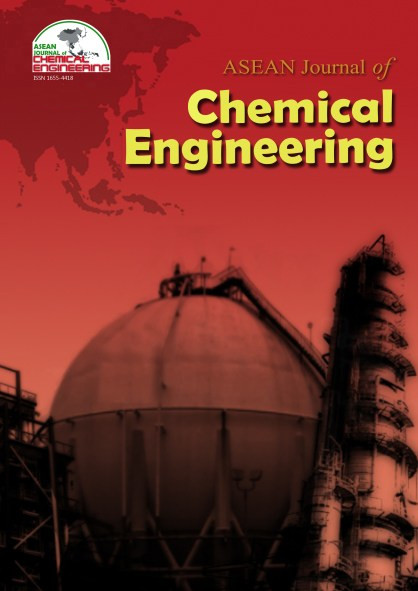The Influence of Carbon Tax on the Feasibility of Industrial Project: A Case Study of Heat Exchanger Replacement at PT Kaltim Methanol Industri, Indonesia
Abstract
Petrochemical industries have faced growing pressure to decrease their carbon emission from direct and indirect sources. This work aims to demonstrate a carbon tax’s introduction to a feasibility study on the heat exchanger (HE) replacement project at PT Kaltim Methanol Industri, Indonesia. The project was aimed to avoid methanol release as much as 48.88 MT/year. The release of methanol can also be associated with CO2 emission with an emission factor of 0.6 ton CO2e/ton methanol. Here, we investigated the influence of inclusion and exclusion of carbon tax to monetize the CO2 release. From the project investment point of view, carbon tax inclusion is expected to increase the cost-saving. Introduction of the carbon tax as high as 10 USD/ton CO2e with 5% annual increase gives IRR value of 7.06% with Payout Time (PoT) of ca. 11 years. The IRR value without carbon tax scenario is 6.68 % with the same range of PoT. Hence, the inclusion of carbon tax may increase the feasibility of the project. This work has demonstrated the positive role of the carbon tax to increase the feasibility of a project which inlines with the national initiatives to curb the CO2 emission from chemical industries. It is also worth noting that introduction of carbon tax should be accompanied by a reorganization of government incentives, including several financial policies to create a conducive atmosphere for investors in Indonesia.
References
2. Ayu, P. (2018).”The Impact of Carbon Tax Application on the Economy and Environment of Indonesia,” Eur. J. Econ. Bus. Stud., 4(1), 110-120.
3. Bank Indonesia, www.bi.go.id, (2020). https://www.bi.go.id/en/moneter/bi-7day-RR/data/Contents/Default.aspx (accessed September 2, 2020).
4. Bhattacharyya, S.C. (2019), “Energy Investment Issues BT - Energy Economics: Concepts, Issues, Markets and Governance”, in: S.C. Bhattacharyya (Ed.), Springer London, London, pp. 469–491
5. Dahlan M. A., Pratama H. B., and Saptadji N. M. (2020) “Pre-feasibility Study of Condensing Wellhead Generating Unit Utilization in Partially Vapor Dominated System,” IOP Conf. Ser. Earth Environ. Sci., 417
6. Gradassi M. J. and Green N. W. (1995) “Economics of natural gas conversion processes,” Fuel Process. Technol., 42, 65–83
7. Huda, H., Handogo, R., Biyanto, T.R. Wu, W., Adi, V.S.K. (2020). “Oil Refinery Heat Exchanger Network Cleaning Scheduling Strategy with Unit Cleanability Consideration”, ASEAN J. Chem. Eng., 20, 31–48.
8. IEAGHG, Sustainability in Petrochemicals, 2019.
9. Jin, Z.-L., Chen, X.-T., Wang, Y.-Q., Liu, M.-S. (2014). “Heat exchanger network synthesis based on environmental impact minimization”, Clean Technol. Environ. Policy. 16 , 183–187.
10. Kang, L., Liu, Y., Liang, X. (2015). “Multi-objective optimization of heat exchanger networks based on analysis of minimum temperature difference and accumulated CO2 emissions”, Appl. Therm. Eng., 87, 736–748.
11. Methanex, Responsible Care and Sustainability Report, 2019. www.methanex.com.
12. Muharam Y., Giffari F., and Mahendra M. (2018) “Techno-economic feasibility of flare gas utilization using adsorbed natural gas,” IOP Conf. Ser. Earth Environ. Sci., 105
13. Müller-Steinhagen, H., Malayeri, M.R. Watkinson, A.P. (2011). “Heat Exchanger Fouling: Mitigation and Cleaning Strategies,” Heat Transf. Eng., 32, 189–196.
14. Müller-Steinhagen, H., Malayeri, M.R. Watkinson, A.P. (2009). “Heat Exchanger Fouling: Environmental Impacts”, Heat Transf. Eng., 30, 773–776.
15. Putro, I.K., Nugroho, A., Hasanudin, N. (2009). “Pemurnian Metanol dari Kandungan Tri Methyl Amine di PT. Kaltim Methanol Industri – Bontang Kaltim”, J. Rekayasa Proses. 3, 30–36.
16. Ratnawati, D. (2016). “Carbon Tax Sebagai Alternatif Kebijakan Mengatasi Eksternalitas Negatif Emisi Karbon di Indonesia”, Indones. Treas. Rev. J. Perbendaharaan, Keuang. Negara, Dan Kebijak. Publik., 1, 53–67.
17. Rokhmawati, A., Sathye, M., Sathye, S. (2015), “The Effect of GHG Emission, Environmental Performance, and Social Performance on Financial Performance of Listed Manufacturing Firms in Indonesia”, Procedia - Soc. Behav. Sci., 211, 461–470.
Copyright holder for articles is ASEAN Journal of Chemical Engineering. Articles published in ASEAN J. Chem. Eng. are distributed under a Creative Commons Attribution-NonCommercial 4.0 International (CC BY-NC 4.0) license.
Authors agree to transfer all copyright rights in and to the above work to the ASEAN Journal of Chemical Engineering Editorial Board so that the Editorial Board shall have the right to publish the work for non-profit use in any media or form. In return, authors retain: (1) all proprietary rights other than copyright; (2) re-use of all or part of the above paper in their other work; (3) right to reproduce or authorize others to reproduce the above paper for authors’ personal use or for company use if the source and the journal copyright notice is indicated, and if the reproduction is not made for the purpose of sale.



